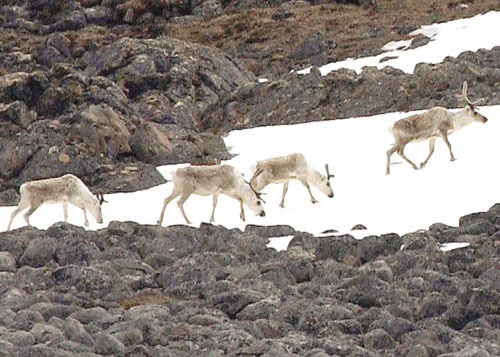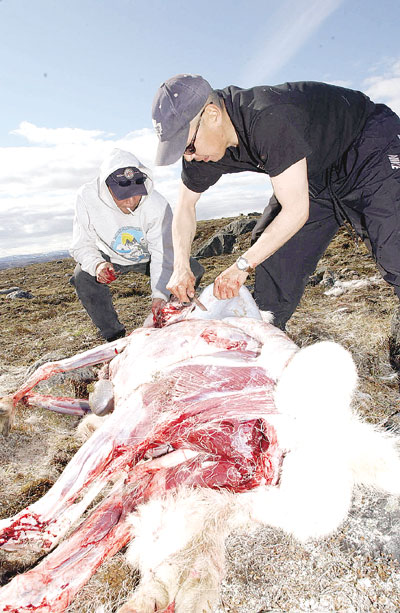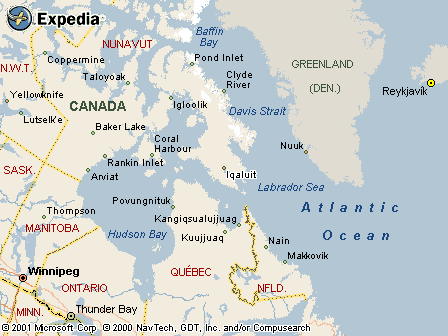|
Caribou
hunting on foot is hard but rewarding work
 The
hunt begins when three caribou appear at close range. The
hunt begins when three caribou appear at close range.
Kakee
Joamie studies the animals through his rifle-scope. He lowers the gun
and tells the group to move on.
"They're
too small," Joamie says in Inuktitut, then in English.
The
group - Joamie, Norman Nowdluk, Etuk Koomarjuk, Ning Davidee and Kerry
McCluskey - start walking. Although they don't know it now, the friends
will return to the Upper Base parking lot six hours later and one caribou
richer.
Joamie,
29, is one of many full-time Inuit hunters in Iqaluit. He, like his father
John Kilabuk before him, feeds his family and friends with meat harvested
from the land and the sea.
Joamie
occasionally picks up part-time work - his most recent job reading Inuktitut
weather broadcasts for the Canadian Coast Guard.
 Not
only is Joamie a proficient hunter, but he's also becoming a legendary
one. Earlier this month, he shot five caribou with four bullets. One killed
two animals because of the way the caribou were positioned. Not
only is Joamie a proficient hunter, but he's also becoming a legendary
one. Earlier this month, he shot five caribou with four bullets. One killed
two animals because of the way the caribou were positioned.
"I've
done it before with ptarmigan, but never with caribou," Joamie says.
The
gang spreads out across the tundra. People without rubber boots avoid
swampy areas by staying on rocky hillsides. An hour into the hunt, Joamie
and Koomarjuk leave the group to get more ammunition.
The
people left behind set up camp. They gather armfuls of quijuktaaq, or
heather. The dry plant is stuffed into a stone oven. The foliage quickly
ignites, heating a half-chicken, lamb sausages, and a kettle of water.
Joamie
and Koomarjuk return in time to finish the left-overs and swallow mugs
of tea.
The
walk continues, up and down and over rolling hills for two hours. There's
plenty of wind and sun but no caribou.
Finally,
five of the sought-after animals are spotted on the horizon. The group
drops to their knees. Joamie fires a shot and a caribou collapses like
a folding chair.
He
knows the animal is dead before it hits the ground.
"I
saw the back of his head explode," Joamie says later.
Koomarjuk
and Davidee take the rifle from Joamie and disappear down a hillside.
They will return an hour later, smiling but empty handed.
Joamie
and Nowdluk stay behind and skin the caribou.
Using
a knife, Nowdluk traces the outline of the caribou from the head to the
tailbone and back to the head. The blade cuts through moist skin and sinew.
Blood gurgles to the surface. The hide is pulled from the carcass like
skin from a chicken breast.
Mosquitoes
are drawn to the scene.
"Thank
god it's windy. Otherwise these bugs would be worse," Joamie says
wiping his brow.
Nowdluk
uses two hands to lift the animal's head off the ground. With one mighty
twist the open-eyed head snaps cleanly from its body. Nowdluk, an accomplished
carver, stands up, stretches his neck and accepts a pre-lit cigarette.
 The
qisaruaq, a stomach pocket, is cut and stuffed with gizzards until it
looks like a water balloon. The
qisaruaq, a stomach pocket, is cut and stuffed with gizzards until it
looks like a water balloon.
"I
can't remember the names, but my old man loves them," Joamie says
of the soft-tissue treats.
The
cutting continues. Each incision revels juicy pieces of the delicious
meat. No one mentions the foul smelling gas wafting from the animal's
warm intestines.
Once
the carcass is cut into several pieces, the meat, including the heart,
is wrapped in the hide and carried 10 kilometres - about three hours -
back to the vehicle parked at Upper Base.
A
portion of the wild meat, including the satchel of guts, is taken to Joamie's
father, who lives at the elder's centre. The remaining meat is divided
between friends.
The
skin will be tossed. Had it been a couple weeks later, and the caribou's
fur thicker and less prone to shedding, Joamie would have saved the hide
for camping.
Despite
the relaxed atmosphere during the hunt, moments of entertaining distress
arose. What alarmed these Inuit hunters was the sight and sound of bees.
Even
when loaded with the caribou meat, Joamie easily outran the group when
confronted with a buzzing insect.
Later,
when asked about the hypothetical prospect of confronting a bee or getting
stuck in a blizzard, Joamie picks bad weather.
"A
storm I could handle because I'd just stay in one place. Bee's sting,"
he says.
|


![]()
 The
hunt begins when three caribou appear at close range.
The
hunt begins when three caribou appear at close range. Not
only is Joamie a proficient hunter, but he's also becoming a legendary
one. Earlier this month, he shot five caribou with four bullets. One killed
two animals because of the way the caribou were positioned.
Not
only is Joamie a proficient hunter, but he's also becoming a legendary
one. Earlier this month, he shot five caribou with four bullets. One killed
two animals because of the way the caribou were positioned. The
qisaruaq, a stomach pocket, is cut and stuffed with gizzards until it
looks like a water balloon.
The
qisaruaq, a stomach pocket, is cut and stuffed with gizzards until it
looks like a water balloon.